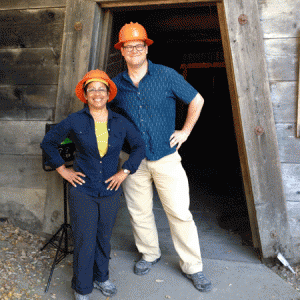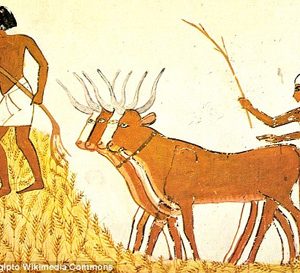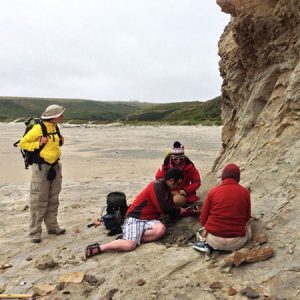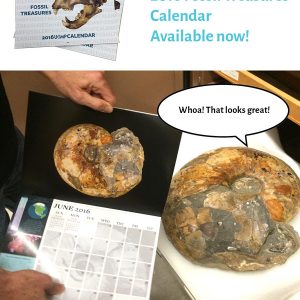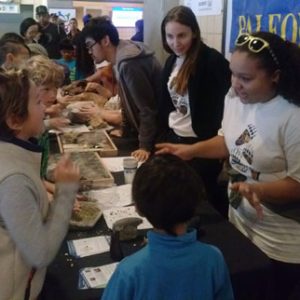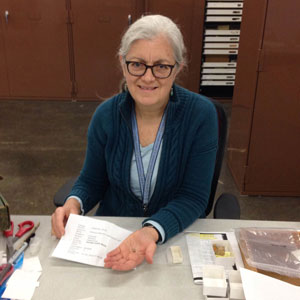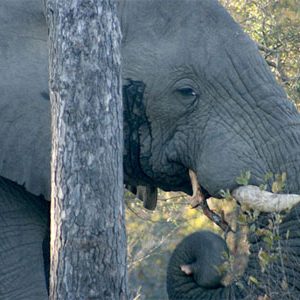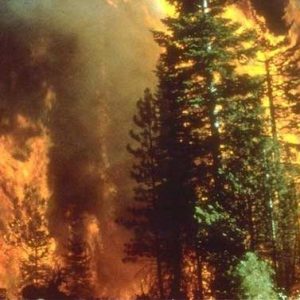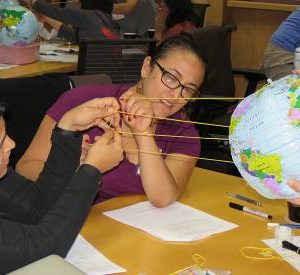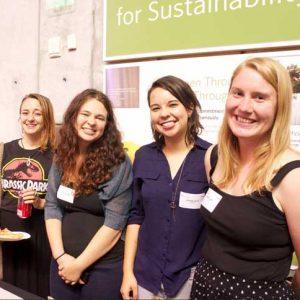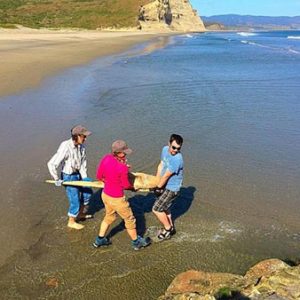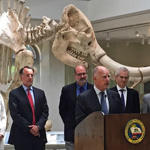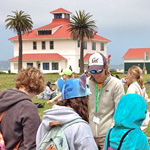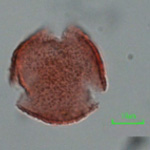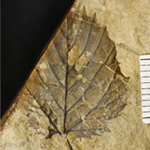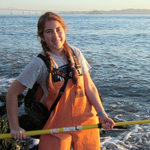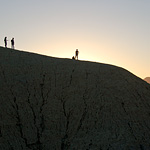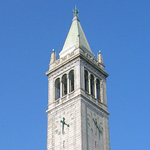Making North America, a 3-part NOVA series that originally aired on PBS in November 2015, is a richly illustrated journey through the geological history of the North American continent. UCMP Director of Education and Outreach Lisa White appears in episodes one (Origins) and three (Human) in segments shot in northern California. Lisa joins paleontologist and Director of the Smithsonian National Museum of Natural History Kirk Johnson, the series host and narrator, along the San Andreas fault in … [Read more...] about UCMP’s Lisa White highlights the geology of California in NOVA series
Latest News
Humans began altering natural world 6,000 years ago
Scientists have found an abrupt change about 6,000 years ago in how terrestrial plant and animal species coexisted, right about the time human populations were ballooning and agriculture was spreading around the world. The findings suggest that human activity had reached a tipping point where hunting and farming were impacting the natural world in irreversible ways — changes that have continued to increase to this day. The researchers, including UC Berkeley’s Cindy Looy, an assistant professor … [Read more...] about Humans began altering natural world 6,000 years ago
National Fossil Day website features research by UCMP and partners
The UCMP partnership with Point Reyes National Seashore and the National Park Service continues to thrive and fossil discoveries made as a result of this partnership are highlighted in a previous post. Lillian Pearson, who works part-time with Museum Scientist Erica Clites cataloging specimens from the Point Reyes National Seashore, is the lead author on an article posted in honor of National Fossil Day (October 14, 2015) describing Cenozoic life and landscape features. National Fossil Day … [Read more...] about National Fossil Day website features research by UCMP and partners
The 2016 Fossil Treasures Calendar is now available at UCMP
Sharing the Collections at UCMP The new year's calendar focuses on the collections and the unique specimens that can be found here. UCMP is a research museum, which means that access is limited to researchers, our students, and affiliates. The 2016 calendar allows us to bring the collections to our supporters and the general public. Grants from the National Science Foundation and the Institute of Museum and Library Sciences enabled us to restore, catalog and digitize new specimens more rapidly … [Read more...] about The 2016 Fossil Treasures Calendar is now available at UCMP
UCMP students help the public unleash their inner scientist
On November 7 UCMP participated in the Bay Area Science Festival Discovery Day at AT&T Park. Discovery Day is the closing event of the annual Bay Area Science Festival – a science extravaganza offering a wide range of science and technology activities in a variety of venues over a two-week period. The UCMP joined other Science@Cal exhibitors for the fifth straight year by engaging youth and families in fossils and life of the past, highlighting what lived at AT&T Park before the Giants! … [Read more...] about UCMP students help the public unleash their inner scientist
UCMP volunteers discover important specimen
UCMP volunteers Kathy Zoehfeld and Don Pecko recently discovered a type specimen from the Smithsonian National Museum of Natural History among the hundreds of thousands of fossils in the former USGS Menlo Park collection. This type specimen, a tiny gastropod called Ceratia nixilia, was discovered in a drawer of fossils they were rehousing into new archival boxes. Don and Kathy not only noticed the less than a centimeter long gastropod, but brought it to my attention because they noticed the … [Read more...] about UCMP volunteers discover important specimen
Landscapes change forever when large mammals disappear
Research on the extinction of large mammals by members of the Barnosky Lab and their colleagues highlights how entire landscapes are affected when modern elephants and their extinct relatives, mastodons and mammoths, disappear. From plants that are no longer grazed to fewer nutrients in soils, the loss of megafauna significantly impacts ecosystems in a dramatic fashion as detailed in recent articles and interviews. Learn more about this recent research: SF Gate Science World … [Read more...] about Landscapes change forever when large mammals disappear
Five Climate Tipping Points We’ve Already Seen, and One We’re Hoping For
This week is Climate Week in New York, when President Obama, Pope Francis, and many other world leaders converge to continue hammering out commitments intended to limit global warming to 2 degrees C or less, to be presented at the make-or-break COP21 climate meetings in Paris in early December. The commitments are not there yet--so far those on the table would allow enough greenhouse gas emissions to raise temperature 3 degrees C or more. But staying below 2 degrees is critically important, for … [Read more...] about Five Climate Tipping Points We’ve Already Seen, and One We’re Hoping For
UCMP and Stanford partner on a global change workshop for teachers
Middle and high school science teachers received double the resources when UCMP and Stanford's School of Earth, Energy & Environmental Sciences teamed up to offer a week-long workshop on global change. Read more about the workshop on Stanford's blog … [Read more...] about UCMP and Stanford partner on a global change workshop for teachers
UCMP science casual: Dinosaur NightLife at the California Academy of Sciences
Imagine over 3,000 adults in San Francisco’s California Academy of Sciences (Cal Academy) for a night of fun special exhibits, drinks, and a serious science social. Now imagine it every Thursday. On July 23rd a dinosaur-themed Cal Academy NightLife event called upon volunteers from UCMP to showcase and explain the mysteries of these monsters beside their contemporary chews. The NightLife also featured a tour of Cal Academy’s library archives about the historic “Bone Wars” between Victorian … [Read more...] about UCMP science casual: Dinosaur NightLife at the California Academy of Sciences
New research shows how mammals became smaller in response to dramatic climate warming
Fifty-six million years ago the Earth underwent a dramatic warming event, with temperatures increasing by as much as 7° Celsius over a span of just 100,000 years. Many mammals responded to this temperature increase by becoming much smaller. How these changes happened, however, is poorly understood. Identifying and measuring the mechanisms that drove these changes was the focus of a new study by University of California Museum of Paleontology researchers Brian Rankin and Pat Holroyd, and … [Read more...] about New research shows how mammals became smaller in response to dramatic climate warming
Partnership with Point Reyes National Seashore leads to important discovery of marine specimen
UCMP's partnership with Point Reyes National Seashore (National Park Service) has resulted in the discovery and collection of an important marine mammal specimen. This specimen is currently being prepared by UCMP Research Associate Robert Boessenecker, and will be reposited at UCMP. Lillian Pearson, a Geoscientist-in-the-Park intern, is setting up protocols for the long-term monitoring of paleontological resources (fossils) at Point Reyes. Erica Clites did this type of work for the National Park … [Read more...] about Partnership with Point Reyes National Seashore leads to important discovery of marine specimen
Barnosky meets with Governor Jerry Brown and a United Nations delegation to discuss climate change
On June 15, UCMP Curator and Integrative Biology Professor Tony Barnosky met with Governor Jerry Brown, Executive Secretary of the UN Framework Convention on Climate Change Christiana Figueres, and California climatologists at the Los Angeles County Museum of Natural History to discuss global warming and the consequences of failing to deal with it. At a press conference following the meeting, Brown expressed his desire to reduce California’s greenhouse gas emissions by 40 per cent over the next … [Read more...] about Barnosky meets with Governor Jerry Brown and a United Nations delegation to discuss climate change
UCMP participates in Girl Scouts’ “bridging” event
Every May for the past 30 years or so, the Girl Scouts of Northern California have celebrated the advancement of their scouts from Junior to Cadette status by a symbolic walk across the Golden Gate Bridge. Following this year’s May 2 event, the scouts continued on to Crissy Field where they enjoyed entertainment and information booths. And UCMP was there to celebrate with the scouts. For the third year in a row, UCMP hosted a table staffed by an enthusiastic crew that included graduate student … [Read more...] about UCMP participates in Girl Scouts’ “bridging” event
A morphological study of living and fossil Quercus (oak) pollen from California using scanning electron microscopy
California has more than 26 oak (Quercus) species, many of which have widespread distributions and different habitats. For example, the California black oaks (Q. kelloggii) are distributed in foothills and low mountains (altitude ~4750 feet), while the Coast live oak (Q. agrifolia; altitude ~830 feet) lives near the coast. Palynologists study the distribution of plant pollen and spores in space and time, and changes in their assemblages reflect changes in regional and local vegetation. In the … [Read more...] about A morphological study of living and fossil Quercus (oak) pollen from California using scanning electron microscopy
Building a forest: The adventures continue in the Jose Creek Member
It's April 18, 2015, and I am sitting in a room at the Charles Motel in Truth or Consequences, New Mexico, the same apartment-style room that I have stayed in during the past four years of field work. Time sure has passed by quickly; from my first paleontological dig as an undergraduate at Texas State University-San Marcos under Dr. Gary Upchurch, to my ambitious inaugural self-guided field trip as a first-year graduate student at Berkeley, to last year's even longer field excursion, and finally … [Read more...] about Building a forest: The adventures continue in the Jose Creek Member
Do green tide algae reproduce all year?
Occurrences of green tides have been on the rise in recent years worldwide. The most impressive have been reported off the coast of China in the Yellow Sea. In August 2014, the Monterey Bay area experienced a green tide that resulted in the accumulation of the macroalgae, Ulva, on its beaches. Algal blooms often make the headlines in spring and summer yet they are not a new phenomenon. In fact, toxic algal blooms may have been responsible for bird, fish and marine mammal die-offs recorded in … [Read more...] about Do green tide algae reproduce all year?
Southern California Spring Break 2015 field trip
Annual field trips used to be something of a tradition at UCMP, but that tradition faded once the Department of Paleontology merged with other units to become the Department of Integrative Biology in 1989. In recent years, former UCMP Director Jere Lipps organized and led three field trips: Baja in 2001, southern California in 2008, and Oregon in 2009. And now two of UCMP’s newest curators, Assistant Professors Seth Finnegan and Cindy Looy, are trying to revive the annual field trip tradition. … [Read more...] about Southern California Spring Break 2015 field trip
The Bearded Lady Project comes to the UCMP
The Bearded Lady Project: Changing the Face of Science came to the UCMP in February, one of many stops in a photographic journey made by documentary film makers seeking to educate the public on gender inequities in geoscience fields, particularly in paleontology. Women of the UCMP sat for portraits that will become part of a photography series intended to celebrate adventurous women who are true pioneers in the fields. See if you can recognize some of your favorite women of the UCMP! … [Read more...] about The Bearded Lady Project comes to the UCMP
Fossils in the Campanile? It’s true!
If you have taken the elevator to the top of Sather Tower, aka the Campanile, perhaps you've heard that some of the floors of the tower are filled with fossils. This is not a campus myth, it's fact! The Campanile is celebrating its 100th anniversary this year and its very first occupants — moving in before the tower was even completed — were fossils. At that time, the museum and Department of Paleontology were in Bacon Hall, just east of the Campanile, so as a storage facility, the … [Read more...] about Fossils in the Campanile? It’s true!
